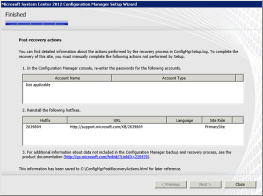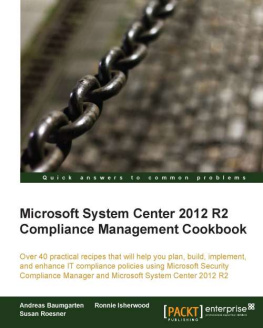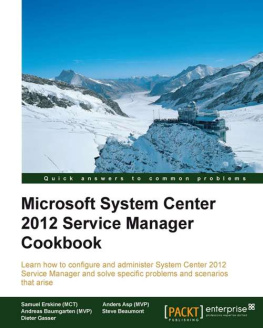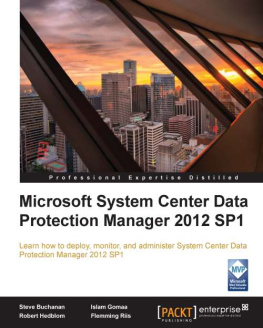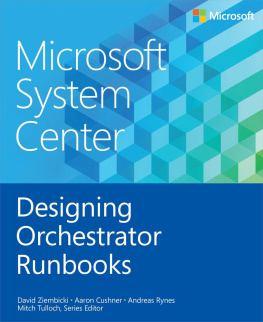PUBLISHED BY
Microsoft Press
A Division of Microsoft Corporation
One Microsoft Way
Redmond, Washington 98052-6399
Copyright 2013 by Microsoft Corporation (All)
All rights reserved. No part of the contents of this book may be reproduced or transmitted in any form or by any means without the written permission of the publisher.
Library of Congress Control Number: 2013956656
ISBN: 978-0-7356-8312-9
Printed and bound in the United States of America.
First Printing
Microsoft Press books are available through booksellers and distributors worldwide. If you need support related to this book, email Microsoft Press Book Support at mspinput@microsoft.com. Please tell us what you think of this book at http://www.microsoft.com/learning/booksurvey.
Microsoft and the trademarks listed at http://www.microsoft.com/en-us/legal/intellectualproperty/Trademarks/EN-US.aspx are trademarks of the Microsoft group of companies. All other marks are property of their respective owners.
The example companies, organizations, products, domain names, email addresses, logos, people, places, and events depicted herein are fictitious. No association with any real company, organization, product, domain name, email address, logo, person, place, or event is intended or should be inferred.
This book expresses the authors views and opinions. The information contained in this book is provided without any express, statutory, or implied warranties. Neither the authors, Microsoft Corporation, nor its resellers, or distributors will be held liable for any damages caused or alleged to be caused either directly or indirectly by this book.
Acquisitions Editor: Anne Hamilton
Developmental Editor: Karen Szall
Project Editor: Karen Szall
Editorial Production: Megan Smith-Creed
Copyeditor: Megan Smith-Creed
Cover Illustration: Twist Creative, Seattle
Cover Design: Microsoft Press Brand Team
Contents
What do you think of this book? We want to hear from you!
Microsoft is interested in hearing your feedback so we can continually improve our books and learning resources for you. To participate in a brief online survey, please visit:
microsoft.com/learning/booksurvey
Foreword
A high percentage of Microsoft System Center 2012 Service Manager projects dont deliver on their promises as they should. While each Service Manager implementation has its own unique challenges, all the successful projects share certain common attributes and experiences. In this book, the authors, Thomas Ellermann, John Clark, Kathleen Wilson, and Karsten Nielsen, who collectively represent close to 60 years of IT consulting experience, express this sentiment and provide a blueprint to help deliver successful Service Manager implementations. This is an undertaking of immense value to the community, and I am honored to be writing this foreword and to recommend the book.
This book is not just for new Service Manager projects. The information presented here benefits existing implementations that are in dire need of optimization. This book is also not a substitute for obtaining detailed knowledge on Service Manager technical information or attending training sessions on Service Manager.
This book is about the organizing principle of Service Manager projects and the various roles in the organization that impact the project. In my experience talking to customers, choosing an ITSM solution today is one of the most difficult challenges facing an IT organization. There are close to 350 vendors claiming this space. Coupled with build-your-own alternatives and an ever decreasing IT budget, a host of certifying bodies, analyst recommendations, and the reality of the disrupting effect of the cloud technologies, selecting an ITSM solution becomes a daunting task, even for the experts. The authors of this book understand this complexity. They have taken the lessons from successful Service Manager implementations and have created a framework that can be leveraged by various stakeholders in an organization to move the needle toward a service oriented delivery model.
Any product so pivotal to changes in business process is bound to have its share of shortcomings. Service Manager is no exception, and the authors explicitly call on the dependencies and shortcomings of Service Manager, making it easier for you to make informed choices. The authors further call on you to challenge your assumptions and pave an improved path to efficiencies that come with automation and standardization.
This book will offer you at least three benefits: You will learn about the capabilities of Service Manager and how it can help you transform service delivery in the modern service-centric business. You will learn how to plan and prepare a Service Manager project. Lastly, you will learn to optimize your current implementation, know about the partner solutions in this space, and improve the productivity of your offerings.
I enjoyed the book and found it valuable. I hope you will, too.
Ranganathan Srikanth
Principal Program Manager, Windows Server System Center (WSSC) at Microsoft Corporation
Introduction
W elcome to Microsoft System Center: Optimizing Service Manager. We (the authors) all work with systems management at Microsoft and believe that the Microsoft System Center suite is one of the most integrated suites on the market for this purpose.
Microsoft System Center 2012 Service Manager is the only product that can integrate across most of the System Center suite and Active Directory. Service Manager is a fast and reliable product that can create and maintain a dynamic service management database to enable interaction across the organization, both inside and outside the IT department, making it a very compelling product to many organizations.
Over the last several years, more and more customers have implemented Service Manager, either independently or via Microsoft or a partner. Sometimes the project and product implementation are not as successful as they should be. Our objectives with this book are to provide you with a framework for planning and delivering a successful Service Manager project and to share some of our experiences and best practices when it comes to optimizing and maintaining your Service Manager environment.
This book is written with three different roles in mind: business and technical decision makers; IT architects; and Service Manager administrators. You can either read this book in its entirety from A to Z, or you can follow one of the learning paths below depending on your role:
Business and technical decision makers:
Business reasons to choose Service Manager
Deployment costs and non-IT usage
IT architects
How to plan for Service Manager
How to prepare for a Service Manager installation
Service Manager administrators
Management packs
Optimizing the Service Manager environment
Service Manager configuration and customization
About the companion content
The companion content for this book can be downloaded from the following page:
http://aka.ms/SCserviceMgr/files
Acknowledgments
We would like to thank the following people who helped review the content of this book for technical accuracy:
Rob van der Burg, Business Program Manager, Microsoft Netherlands
Jon Sabberton, Architect, Microsoft Gulf, United Arab Emirates
Murat Erentrk, Senior Architect, Microsoft MEA HQ
Errata & book support
Next page



